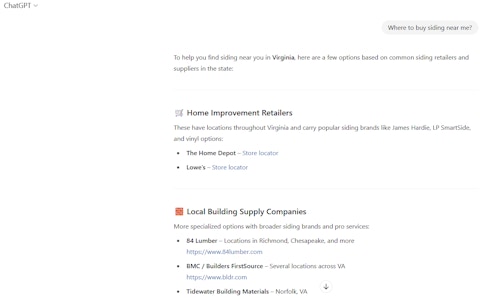AI is changing how people discover and interact with content online. If you’ve noticed a drop in organic traffic in your business performance despite an increase in impressions, it’s likely because of AI Overviews, a new Google feature that uses large language models (LLMs) to generate quick summaries directly in the search results.
In the meantime, platforms such as ChatGPT, Perplexity and Claude LLM-powered are becoming alternative search channels in themselves, all operating and impacting your website visibility differently.
Understanding how these technologies work and what that means for your SEO strategy will help you conquer the ever-changing world of AI and stay competitive in your space.
What's the Difference Between AI Overviews and LLMs?
AI Overview is a feature on the Google Search results page (SERP) that uses large language models (LLMs) together with Google's main ranking algorithms to generate concise summaries.
These summaries have sources and often include links to websites. While this can boost brand visibility, it tends to drive less traffic because users often get the answer without clicking through.

While LLMs like ChatGPT or Perplexity are stand-alone AI tools trained on a mix of online content and public data, they won’t always include a source. That is only displayed to the user when the prompt explicitly requests source information.
Additionally, they do not necessarily send traffic unless the question requires real-time information (e.g., "Where to buy siding near me?"). They respond generally based on their internal knowledge, not live search results.

Why Is Your Organic Traffic Dropping?
Your content can get more views, but fewer people click through to your site. Why?
Google's AI Overview feature uses LLMs to display direct answers and summary results online, so users often find what they're looking for without having to click through.
According to a recent SEMrush study, AI Overviews are growing at a very rapid pace. In March 2025, 13.14% of queries overall triggered AI Overviews, nearly twice that of January 2025, when it was 6.49%. This is especially seen in the case of information content, which accounts for 88.1% of queries to trigger AI Overviews.

Another major factor is how fast ChatGPT is growing compared to Google. According to Ahrefs’ ChatGPT vs Google report, which analyzed data from over 100,000 websites using their free Web Analytics tool, traffic from ChatGPT grew by 5.3%, compared to Google’s 1.4%.
41.9% of all web traffic is driven by Google and 0.19% by ChatGPT. Google has been around for more than 25 years, while ChatGPT is not even 3 years old yet.
Google is still the traffic king, but ChatGPT is the fastest-growing challenger. That’s why it’s so important now to focus on making your content not just visible, but useful and quotable, so it gets picked up and referenced where it matters.
What Makes Your Brand Show Up in the AI Overview
Now that you know how AI Overview works, it’s time to understand how you can benefit from it and how your content can get featured.
If you want your brand to be seen as the expert, give buyers instant access to find exactly what they need.
Use your website to guide them through the decision-making process with content that answers their questions. For example, you might publish articles on topics like “the best roofing systems for hot climates” or “important factors for cladding code compliance”.
Use comparisons to highlight what makes your product different. Back it up with technical insights, real-world installation guides and reviews from people who’ve actually used it.
When your content does the heavy lifting, your brand becomes a go-to source for insights.
Use Structured Data to Help LLMs Understand Your Content
LLMs powering tools like ChatGPT and Google SGE don’t just read your website — they analyze how it’s structured. The clearer the content and the cleaner the data, the easier it is for AI to choose your brand as the answer. That’s where schema markup comes in.
Schema markup is a code that helps search engines and AI tools understand what your content means, not just what it says. Think of it as labeling a digital file cabinet. Instead of sharing unorganized information online, you’re tagging it so LLMs can tell exactly what it is — like a product, a review or a spec sheet.
For building materials companies, this is the difference between visibility and being overlooked by dealers, distributors, builders and professionals.
Your digital marketing team or web developer should be adding schema to these key pages:
- Product detail pages
- Technical documents
- Installation guides
- Case studies and blog posts
- FAQ pages
Use structured data to highlight your product names, technical specifications, installation steps, material safety data and more. If you published a how-to guide, mark it up as a “How To” so LLMs can recognize and share it for a step-by-step resource.
Schema markup is how you appear when AI tools go looking for answers, boosting your chances of becoming a trusted online source. Right now, that’s how more and more customers are discovering new products.
Publish Answer-Optimized Content
In marketing, the rule of thumb is to always focus on serving the customer.
When you understand your buyer’s journey — what they’re trying to solve and what they need to know — they’ll feel like your site was built just for them. So will AI.
The goal is solution-driven content, which gives your audience the tools and information they need at every touchpoint in the sales funnel.
Use natural language written with a conversational flow using Q&A-style headings like, “What’s the most fire-resistant siding material?” Be sure to write clearly and directly.
When you’re answering real concerns, don’t chase keywords. Directly answer your audience’s top questions. Break content into clear, topical paragraphs with proper headings where they’re applicable. Insert side-by-side comparisons and summarize with quick key takeaways. Keep it precise so LLMs can index your pages instantly without any confusion.
Pitch your building products expertise to land features in recognized trade media outlets like Pro Builder, JLC or LBM Journal. Apply to join building associations or directories like Green Builder Magazine or EDC.
In the digital world, these aren’t just backlinks — they’re trust signals. Manufacturers can also aim for coverage from sources like .org and .edu domains, where AI tools find contextual, authoritative, unbiased information.
Relationships are vital in our industry. Aim to build partnerships that could lead to relevant mentions, like a product in a builder training resource or a spec sheet linked in an educational course. The more credible sources that reference your product, the more likely AI will see your brand as a worthy recommendation.
From Ranking to Referencing: The New SEO Funnel
The traditional SEO model focused on ranking, clicks and conversions, but in an AI-first world, the funnel looks different:
Old Funnel:
Content → Rank → Click → Convert
New Funnel:
Content → Reference by AI → Visibility → Trust → Assisted Conversion
The focus is no longer just getting traffic, but being trusted and optimized enough to be quoted by AI tools your customers already use.
A Quick Recap
These key insights will help you understand how to adapt your SEO strategy for the AI-first search landscape and keep your building materials brand visible and trusted.
- Visibility ≠ Clicks: Impressions may rise even as clicks and CTR decline because users get answers directly from AI-generated summaries.
- Focus on becoming a referenced source: Optimize your content to be clear, trustworthy and structured so AI models choose and quote your brand.
- Use structured data (schema markup): Tag key pages like product details, installation guides and FAQs to help AI understand and feature your content.
- Create answer-focused, solution-driven content: Write conversational, Q&A-style content that directly addresses customer questions and needs.
- Build credibility through trusted mentions: Seek features in respected industry publications and associations to boost your brand’s authority in AI search.
- Think beyond rankings: Success now means being quoted by AI tools, not just ranking high or getting clicks.
The Bottom Line
As AI-generated content summaries increase on Google and third-party platforms, becoming the new “position zero,” brands that optimize for clarity, authority and attribution will emerge as category leaders.
Because of this, there’s one question that may soon matter more than any traffic metric: “How often is our brand being quoted by AI?” The winning brands will be those who shape the answers, not just chase the rankings.
Now is the time to future-proof your strategy. Need help navigating SEO and the ever-changing world of AI? The experts at Venveo can help. We offer cutting-edge marketing techniques to various manufacturing industries, delivering long-lasting results that help drive success. Reach out to book a call with our team today.








